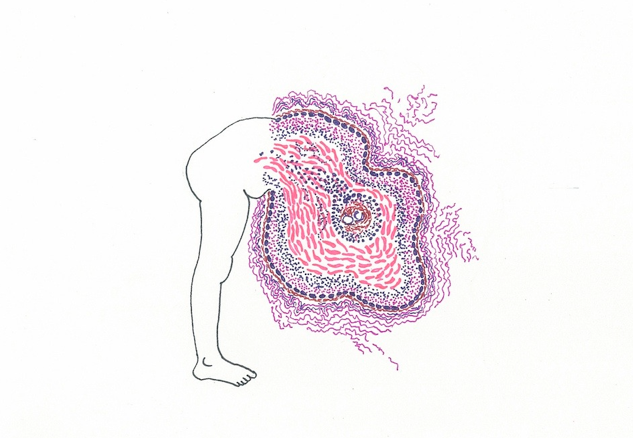
ÉCOFEMMES FEST – MINERVA
L’association MINERVA présentera ÉCOFEMMES FEST, le premier festival en France consacré à l’écoféminisme. Pendant trois jours, artistes, chercheuses, journalistes et…

Crédit image : Siobhan McGibbon, The Cell That Consumed Me, 2014. Ink on paper. Courtesy of the artist.
Gut Instinct
Art, food and feeling
November 25, 2016–March 19, 2017
Artists: Marina Abramovic, Sonja Alhäuser, Domestic Godless, Elif Erkan, Fiona Hallinan, Siobhan McGibbon, Abigail O’Brien, Thomas Rentmeister, Neil Shawcross
Curated by Chris Clarke, John Cryan and Fiona Kearney
Food has long been the subject of works of art. In recent times, artists have also examined eating behaviours and the mechanisms of consumption as a way to comment on contemporary society. From artworks that explore the materiality of foodstuffs to creative provocations that test the boundaries of good taste and revulsion, Gut Instinct: Art, food and feeling draws on cutting edge research by John Cryan, Professor and Chair, Anatomy and Neuroscience, University College Cork, to explore how digestion relates to our mental and emotional states.
The wider cultural associations of food, its significance in the rituals and routines of everyday life, are featured in several works. Abigail O’Brien’s installation comprises sculptures, video and photography that reveal the role bread plays in our shared culture: metallic loaves are arrayed across a series of tables while, in her photographs, images of kneading and baking dough are named after her female artistic peers. Marina Abramovic‘s film The Onion offers an uniquely physical take on language and identity. The artist eats a raw onion while recounting a litany of complaints, the camera offering an unflinching portrayal of her discomfort and disgust.
The emotive connection that individuals have to different foods is captured in Neil Shawcross’ paintings. His portrayals of tins of soup, bottles of ketchup, packets of cake mix and various foodstuffs are rendered in expressive brush strokes, conveying the emotional attachments we have for particular brands, comfort foods and favourite condiments. A similar sense is found inThomas Rentmeister’s Untitled, a vast, painted field of densely textured Nutella chocolate spread. Just as the scale of the work overwhelms the viewer, the sickly sweet smell pervades the gallery space, conjuring a reaction that is at once enticing and revolting. In Rentmeister’s other work here, a rounded mound of rich brown resin recalls a giant sweet, a globule of chocolate that may have dropped from his nearby painting. In Fiona Hallinan’s installation, plate-like platforms are suspended by cords and pulleys to create an interactive site that serves as both a sculptural arrangement and a space for public events. Food is not simply a means of sustenance: instead, it serves to encourage conversation, communication and conviviality.
The correlation between these two « brains »—the state of gut and the state of mind—is exemplified in artworks that blur the distinctions between mind and body. In Siobhan McGibbon’s sculptures, pristine white figures appear to melt into indefinable masses of dripping fat and flesh, while her drawings depict microbes merging with simplified human forms. Elif Erkan’s Lotus Eaters also employ an unusual approach to her materials, as the artist « feeds » vitamins such as St. John’s Wort and Omega 3 into abstract plaster forms to reveal unexpected juxtapositions of the organic and the synthetic. The infusions either disappear into their materials or slowly, visibly, rot and decay. In the work of Domestic Godless, performative events introduce participants to strange—and often repulsive sounding—new recipes. Their installation explores notions of disgust and digestion and includes custom-made toothpastes and suppositories. Sonja Alhäuser’s work exemplifies many of the concerns found throughout Gut Instinct. Her drawings, including several new works draped along the walls, combine portrayals of feasts and harvests, anatomical diagrams and playfully absurd sketches, to represent the indistinguishability of our mental and bodily lives. Here, these domains are intertwined, each feeding into the other.
Gut Instinct features a curated programme of events including a public symposium on art and food on February 25, 2017. The exhibition is accompanied by a catalogue. For further information, please email exhibitions(at)glucksman.org.
Gut Instinct: Art, food and feeling is supported by University College Cork, The Arts Council Ireland, Science Foundation Ireland, and private philanthropy through Cork University Foundation.
Gut Instinct
Art, food and feeling
November 25, 2016–March 19, 2017
The Glucksman
University College Cork
Cork
Ireland
Hours: Tuesday–Saturday 10am–5pm
T +353 21 490 1844
info(at)glucksman.org
www.glucksman.org
Facebook / Twitter / Instagram
L’association MINERVA présentera ÉCOFEMMES FEST, le premier festival en France consacré à l’écoféminisme. Pendant trois jours, artistes, chercheuses, journalistes et…
La Galerie Maubert consacre une exposition personnelle à Nicolas Floc’h, figure majeure de la scène contemporaine française dont le travail…
L’Observatoire de la Côte d’Azur accueille Unda Terræ, une exposition collective art/science imaginée par Circa dans le cadre de la…

